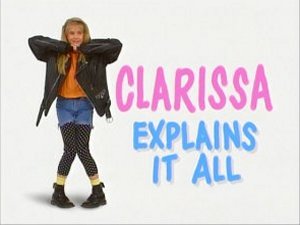
Nowadays, marketing to the tween demographic is a no-brainer. Networks like the Disney Channel make a large chunk of their profits off a tween audience, and it's become generally good entertainment market practice to appeal to the eight-to-twelve set. Back in the early 90s, however, there had yet to be a major leap in marketing to preadolescents. There was a wealth of children's programming and teen-programming, but very little in the way of in beTween.
Nickelodeon was pretty pioneering in Tween entertainment, particularly with its popular sitcom Clarissa Explains It All. Clarissa Explains It All featured a star who was conveniently on the younger age of her teenage years, allowing the network to promote the program to teens and tweens alike.
Though the show confronted teen issues, it didn't do it in the Very Special Episode style so popular with contemporary family sitcoms. The stories were told through the lens of Clarissa's quirky and ironic personality, with a whole bunch of ridiculously awesome 90s fashion risks* thrown into the mix.
The show also featured an outstandingly catchy theme by Rachel Sweet, whose incessant na-na-na-nana-ing punctuated with well-timed "alright, alrights" and "hey cools" made it difficult not to want to at least hum along.
At the time I remember the incredible fervor with which I coveted her outfit in the opening sequence, though in retrospect it's a tad bit trampy. I had innumerable arguments with my mother about midriff shirts, as no doubt many young 90s girls across the country were having with their respective parents.
Here our parents were, thinking Nickelodeon was wholesome programming, all while its subliminally encouraging us to go seeking Clarissa-grade streetwalker boots, tights, and miniskirt combos. In all fairness, I still think she totally rocks it, so I suppose its moderate sluttiness is excusable.
Clarissa was famous for breaking the fourth wall with a frequency that would make Zack Morris blush. This wasn't an occasional wink or nod to the audience, she went all the way with Ferris Bueller-grade audience-directed monologues. It was almost as if she were just some friend of ours who happened to live in our television set. She was funny, she was honest, and most of all, she was an individual in every sense of the word.
From the very beginning, Melissa Joan Heart gave Clarissa that X factor of immediate likability. Watch her introduce herself in this segment of the first episode and just try not to think she's just a little bit cool. It's nearly impossible.
The first episode was a bit risque in terms of thematic content as it centered around Clarissa's plot to eliminate her irritating little brother. It doesn't exactly sound like the stuff great kids' programming is made of, but it managed to pull it off in a lighthearted and comic enough way to make it work and sufficiently endear her to us as a character.
We see many of the recurring gimmicks in the first episode, showing just how well-developed the series was upon its inception. The show made use of all sorts of visual aids that would handily appear in the right-hand corner of our screen, later the basis of CNN--the Clarissa News Network. She has a miniature alligator named elvis that lives in a sandbox in her room, and her best friend Sam stops by via a ladder hooked to her second-floor window. There were flashbacks and musical cues. It all flowed together nicely, creating an original work of kid-driven entertainment.
 What I wouldn't give for a little headline image to come up alongside me as I address the audience directly.
What I wouldn't give for a little headline image to come up alongside me as I address the audience directly.The show was smart and fast-paced, and it talked to kids rather than at them. Sure, there were some hints of what is considered right or wrong, but it wasn't shoved down our throats After-School Special Style. This wasn't Full House or even Saved By the Bell. It wasn't about learning lessons, it was about commiserating with a preteen-to-teen-age character who was going through all the same things we were.
We'd all suffered her humiliations and dealt with similar growing-up traumas. Clarissa was a role model without being a Pollyanna. She wasn't necessarily who our parents would pick to guide us, and that's a lot of what we liked about her. She's who we would have chosen, after all.
It's also notable that Clarissa was among the first Nickelodeon female leads. It's nearly unthinkable in the days of Hannah Montana and its ilk that children's networks didn't see young girls as a legitimately targetable demographic, but in the early 90s it was still all shiny and new. Clarissa wasn't much of a girly girl, allowing her to appeal fairly well to both genders.
Clarissa fakes sick to avoid a school play, laments being forced to wear an uncool outfit on picture day, yearns for her driver's license: in short, we didn't have to love her because she was extraordinary, but more because she was ordinary. For once, the networks had gotten it right and put one of our own kind out there saying the things that we say, doing the things we do, and being annoyed by the things that annoy us too. She was like a cooler version of our preteen selves. After all, she had her own theme song and news network; we couldn't exactly compete with that.
*Am I the only one who automatically associates the phrase "fashion risk" with the movie Girls Just Wanna Have Fun? It just makes me want to say, "You're taking a fashion risk, I like that. Just don't do it on TV." Anyone? Anyone? Just me? Okay then.






0 comments:
Post a Comment